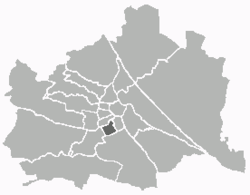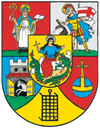Margareten
| Margareten | ||
|---|---|---|
| 5th District of Vienna | ||
|
||
 Location of the district within Vienna |
||
| Country | Austria | |
| City | Vienna | |
| Government | ||
| • District Director | Susanne Schaefer-Wiery (SPÖ) | |
| • First Deputy | Andrea Hallal-Wögerer (SPÖ) | |
| • Second Deputy | Nikola Furtenbach (Green) | |
| • Representation (40 Members) |
SPÖ 16, Green 10, FPÖ 8, ÖVP 3, NEOS 2 ANDAS 1 |
|
| Area | ||
| • Total | 2.03 km2 (0.78 sq mi) | |
| Population (2016-01-01) | ||
| • Total | 54,940 | |
| • Density | 27,000/km2 (70,000/sq mi) | |
| Postal code | A-1050 | |
| Address of District Office |
Schönbrunner Straße 54 A-1050 Wien |
|
| Website | www.wien.gv.at /bezirke/margareten/ |
|
Margareten (German pronunciation: [ˌmaʁɡaˈʀeːtn̩]; Bavarian: Magredn) is the fifth district of Vienna (German: 5. Bezirk, Margareten). It is near the center of Vienna and was established as a district in 1850, but borders changed later. Margareten is a heavily populated urban area with many workers and residential homes.
The district of Margareten was formed from six suburbs. The former city of Margareten itself developed from an estate with the same name and was later built into a castle. It was destroyed in both Turkish sieges of Vienna, but rebuilt each time. Nearby lay Nikolsdorf, which was systemically laid out in the period 1555-1568 and named after the convent of St. Nikolai. Matzleinsdorf emerged in 1130 and was property of the Babenberger family. The name Laurenzergrund ("St. Lawrence ground") comes from an area in Matzleindorf with the Laurenzer gully. After the closing of the convent by Emperor Joseph II, it became an independent city.
Reinprechtsdorf was a village in the Middle Ages, abandoned earlier, but the name remained as a path waypoint. In 1730, residential houses were again built in the area. Nearby, a hunting lodge was built, wherefrom the suburb Hundsturm ("Hounds tower") gets its name. The hunting lodge was later replaced with a fort, which was taken down by 1885.
Those six areas, along with a number of others, were incorporated on March 5, 1850, into the fourth district of Wieden. After a long debate over the different social circumstances of the population, in 1861 the fifth district was separated. In 1873 the district lost its southern area to the, much larger, 10th district, Favoriten. Since then, the formerly rural district has become a thickly populated urban area with many workers and eventually large residential homes.
Margareten is in the southwest of Vienna and is bounded to the north by the Vienna River, in the west and south by the Gürtel belt. The Vienna River is also the border to the district Mariahilf, while the belt is the boundary of the districts Favoriten and Meidling. The eastern district boundary with Wieden runs contrary to the other inner districts in the transverse rather than longitudinal. Thus, the district boundary follows the streets: Kettenbrückengasse, Margaretenstraße, Kleine Neugasse, Mittersteig, Ziegelofengasse, Blechturmgasse until the Gürtel belt. Margareten is the only district within the Vienna Belt which is not within the Inner City borders.
The district area is part of the Katastralgemeinde Margareten, which has a hectare of the territory of the neighboring district Mariahilf. The lowest point in Margareten is nearly 174 metres (571 ft) in the Wiental. In the south (at Wienerberg hill), the land rises slightly. Margareten has no sharp altitudes, or mountains: the total height difference is approximately 30 metres (98 ft).
...
Wikipedia

